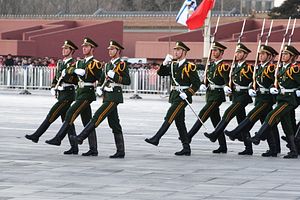China is entering a new age of military diplomacy.
The Chinese military has historically played an unusual role in the transnational community of military professionals. While the Nationalist armies relied on considerable support from Western military forces, including German, British, American, French, and Italian advisors, the early PLA was far more isolated from international influence. The PLAN and PLAAF depended on advice from and interaction with the Soviet Navy in the years following the Revolution. During the Cold War, Chinese officers advised insurgents around the world, as well as offering direct support to kindred organizations in Vietnam and North Korea.
But today’s PLA is a professional force, and for the last two decades it has expanded its presence and influence in the international military community, a trendline that has ticked distinctly up in the last year. This includes not only the participation of the PLAN at RIMPAC, but also PLAAF exercises in Pakistan, PLAN joint exercises with the Russians, and PLAAF participation at Aviadarts.
Military diplomacy can play several important roles. On the one hand, it can serve as a useful source of intelligence about foreign military organizations, and in particular about the specific personnel in foreign organizations. This need not involve shady intelligence work; the development of personal relationships can help grease the wheels of multilateral operations. This is particularly helpful for operations that don’t involve “kinetic” competition, such as humanitarian assistance and disaster relief. Knowing that right person in the PLAN to call, and knowing that she’ll pick up the phone, can be enormously important to getting things done in a crisis situation.
The United States Navy has even structured the greater part of its strategy around the potential for military diplomacy and maritime engagement. The Cooperative Strategy was designed to create the basis for developing relationships between American officers and their foreign counterparts, and also on creating a network of naval expertise accessible to many who needed it.
Exercise diplomacy, such as RIMPAC, can also help display military power and effectiveness. States that don’t want to fight wars often see displays of power as a way of emphasizing deterrent power. This is perhaps one reason why the U.S. Navy expressed little concern over China’s attempted spying at the RIMPAC exercise. Showing off can pay off, especially when the one’s watching (naval officers) are the most capable of appreciating skill and power.
The PLA doesn’t yet quite have a “cooperative strategy,” but it has clearly expressed a serious interest in the fruits of cooperation, at least at organizational and interpersonal levels. These sort of contacts don’t generally shift the course of nations, but they can have a big impact on the everyday functioning of a military.
































